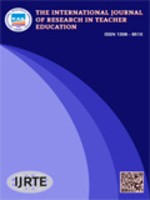An Evaluation Of The Effects Of Teacher Employment Under Different Statuses On The Levels Of Teachers' Organizational Commitment: A Case In Amasya
An Evaluation Of The Effects Of Teacher Employment Under Different Statuses On The Levels Of Teachers' Organizational Commitment: A Case In Amasya
In this study, it is intended to compare contracted and permanent primary school teacher’s levels of organizational commitment with regard to the commitment to school, to teaching works, to occupations and to colleagues. This study was conducted on a total of 757 primary school teachers, 610 of which were permanent teachers and 147 were contracted teachers who work in Amasya province and its districts in the academic year 20092010. Celep’s (2000) ‘Teachers' Multidimensional Organizational Commitment Scale’ was used for the collection of data on the study. The scale is developed to measure teachers’ organizational commitment at educational organizations and it consists of 28 items which were divided into four dimensions including commitment to school (9 items), commitment to teaching occupation (7 items),, commitment to teaching work (6 items), commitment to work group (6 items). The construct validity of this scale was assessed by factorial analysis. For construct validity of scale, it is observed that items load highly on four factors as a result of the rotation procedures with factor analysis. To determine the reliability of the scale, first of all it is computed discrimination coefficients of 28 items as a onedimensional. The coefficient of internal consistency was determined for both one dimension and each factor. In the organizational commitment scale of educational organizations, a total of 28 items have reliability coefficients of .88. Cronbach's alpha coefficient is computed .80 in the dimension (or factor) of commitment to school, .75 in Commitment to Teaching Occupation, .78 in Commitment to Teaching Work and .81 in Commitment to Work Group. ANOVA, t-test was used for data analysis and the Levene test is to assess the equality of variances. The results with P <0.05 were considered as statistically significant. According to the results of the analysis, the organizational commitment points of the 610 permanent teachers was 107.93, and the average answers given to the questions was 3,9 and the organizational commitment points of the contracted teachers was 104.66 and the average answers given to the questions was 3,7. When examined separately, the views given by the permanent teachers to organizational commitment was “little” and “from time to time” level, and the contracted teachers responded as “little”. According to this a difference at p<0.05 level was observed between the permanent teachers and the contracted teachers in respect to organizational commitment level in primary schools. (p=0.04). The difference is statistically significant in favour of permanent teachers. The permanent teachers’ level of commitment to Teaching Work ( :4.22) turned out to be lower than that of the contracted teachers. The permanent teachers’ level of commitment to school ( : 3.46), was higher than that of the contracted teachers ( :3, 23). The permanent teachers’ level of commitment to work group ( : 3, 75), was found to be higher than that of the contracted teachers. ( :3, 42). Also, permanent teachers’ the average point of commitment to teaching occupation was 4.13 while contracted teachers’ the average point of commitment to teaching occupation was 4.05. Additionally, it was examined whether level of organizational commitment change in terms of the variables such as gender, seniority, and the branch. Consequently, it is concluded that the employment of equally qualified personnel under different statuses creates discrimination, and that this situation adversely affects their Organizational Commitment Levels and therefore, it can be said that this application should be avoided. Key-words: Organizational Commitment, Permanent Teacher, Contracted Teacher, Multi Dimensions of Commitment, Primary School.
Keywords:
-,
___
- Balay, R. (2000). Yönetici ve Öğretmenlerde Örgütsel Bağlılık. Ankara: Nobel Yayın ve Dağıtım.
- Ce lep, C.( 2000). Eğitimde Örgütsel Adanma ve Öğretmenler. Ankara: Anı Yayıncılık.
- Glisson, C., & Mark, D. (1988). “Predicters of job satisfaction and organizational commitment in human service organizations”. Administrative quarterly. Cilt 33, 61-81.
- Kapta n, S. (1976). Bilimsel Araştırma ve İstatistik Teknikleri. Ankara: Bilim Yayınları.
- Karasar, N. (1994). Bilimsel Araştırma Yöntemleri. Ankara: Araştırma Eğitim Danışmanlık Ltd.
- Kartepe, H.(2011). Sözleşmeli Personel İstihdam Politikasında Değişim ve Günümüz Uygulamaları, Bütçe Dünyası Dergisi, Sayı 35.
- Özgüven, İ. E. (2003). “Endüstri Psikolojisi”. Corporate governance. Cilt 7, Sayı 1, 17
- Swailes, S.(2002). “Organizational Commitment: A Critique of the Construct and Measures.International”. Journal of Manag ement Reviews. Cilt 4, Sayı 2, 155–178
- Tsui, Kwok-tung vd. (2002). “The Relationship of Teachers' Organizational Commitment to Their Perceived organizational Health and Personal Characteristics in Primary Schools”.
- Reichers, Ida Marie (1985).The role of commitment in collective action: comparing the organizational behavior and rational choice perspectives. Public Administration Review | January 01, 1995 | Robertson, Peter .; Tang, Shui-Yan |
- Savgun Doğruöz, S. (2009). Kadrolu ve Sözleşmeli Öğretmenlerin Örgütsel Bağlılık Düzeylerinin Karşılaştırılması.Ondokuz Mayıs Üniversitesi Sosyal Bilimler Enstitüsü, Yayınlanmamış Yüksek lisans Tezi.
- Serim, B. (1987). Öğretide Yargı Kararlarında ve Uygulamada Sözleşmeli Personel, Gümüş Matbaası. 2007 tarihli ve 5620 sayılı Kamuda Geçici İş Pozisyonlarında Çalışanların Sürekli İşçi Kadrolarına Veya Personel Statüsüne Sözleşmeli Geçirilmeleri, Geçici İşçi Çalıştırılması İle Bazı Kanunlarda Değişiklik Yapılması Hakkında Kanun, 21 Nisan 2007 tarih ve 26500 sayılı Resmi Gazete. 6.6.1978 tarihli ve 7/15754 sayılı Sözleşmeli Personel Çalıştırılmasına İlişkin Esaslar Bakanlar Kurulu Kararı, 28 Haziran 1978 tarih ve 16330 sayılı Resmi Gazete.
- ISSN: 1308-951X
- Başlangıç: 2010
- Yayıncı: Eğitim Araştırmaları Birliği Derneği
Sayıdaki Diğer Makaleler
Kemal Akkan BATMAN, Salih SARPTEN
Sabit MENTEŞE, Ahmet ÜSTÜN, Seçil Savgun DOĞRUÖZ
A New Model In English Language Classroom: Howard’s Multiple Intelligences Theory
İlköğretim I. Kademe Görsel Sanatlar Dersinin Verimini Artırmaya Yönelik Bir İnceleme
Employment Of Active Learning In Classroom Management And It’s Effect On Students’ Academic Success
